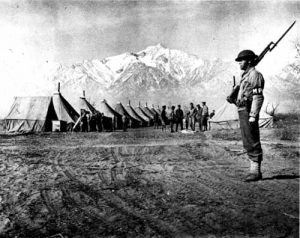War Relocation Center Name Sugarcoats Sad American History
Within hours of the attack on Pearl Harbor on December 7, 1941, the FBI began rounding up suspected “enemy” aliens, targeted solely because of their Japanese heritage.
That began what would end up being the incarceration of over 120,000 individuals in internmen camps throughout the United States.
Just two months later, on February 19, 1942, President Franklin Roosevelt signed Executive Order 9066, beginning the process of establishing Japanese internment camps run by the U.S. Army’s Wartime Civilian Control Administration, then subsequently by the War Relocation Authority.
Although the official name of the facilities were “War Relocation Centers”, the ten internment camps set up in various states were nothing more than prisons set up to house thousands of men, women, and children suspected of being disloyal to America simply because of their heritage.
Some of those incarcerated were recent Japanese immigrants, but the vast majority were U.S.-born citizens. Some were even second and third generation Americans, forcible taken from their homes, schools, businesses, and communities and shipped like prisoners to uncertain fates.
The closest War Relocation Center to San Diego was Manzanar, a 540-acre site along Highway 395 south of Mammoth Lakes in Northern California. The barren camp of sand and sagebrush was surrounded by barbed wire fences and eight watch towers with spot lights and machine guns, not to keep people out, of course, but to keep them in.
The Manzanar camp was made up of 36 blocks of barracks, and included gymnasiums, mess halls, laundries, schools, and recreation areas. Although life within the camps grew to become similar to a small community, not unlike that of a town, the inhabitants were still forced prisoners in their own country.
Life at Manzanar was harsh both in the hot summers and the cold winters. The howling winds always blew sands storms across the camp. Kids went to school and played in the open dirt fields. Bare of any trees and flowers, internees eventually created gardens and lawns to give their forced captivity some semblance of normalcy.
Besides the incarceration, itself, one of the most insulting and hypocritical aspect of life in Manzanar was that kids within the camp attended school and, like all young kids do, learned about the Constitution. Imagine the feeling of studying about the freedoms enshrined in the Constitution while being incarcerated based solely on ethnicity, without any due process or other constitutional protections.
After nearly four years of operation, Manzanar was closed on November 21, 1945, becoming the sixth of the ten camps to be shut down. When the camps closed, the U.S. government gave each person $25 and a one-way train or bus fare back home.
But after being ripped from their homes and business years earlier, many had nowhere to return. Although some left the camp voluntarily, many refused to leave. In a sad irony, the government that had forcibly brought them to Manzanar now had to forcibly remove the former prisoners.
Today, Manzanar is a National Historic Site run by the National Park Service. The camp hosts a museum within the restored High School Auditorium built during the years of operation, and features exhibits, artifacts, and a small theatre that runs a 22-minute movie about life within Manzanar. The movie is narrated by people that lived at Manzanar, voiced over powerful pictures depicting life within the camp.
Visiting Manzanar is a powerful reminder of the fragility of our liberty when society faces threats of war and insecurity. At a time of war, America turned inward and turned against some of its own neighbors just because they resembled the enemy.
Today, during another time of war, America could again turn inward, and turn against another community of neighbors that resembles the enemy. That would be a mistake, and a repetition of an sad chapter in our history.
America has grown into an eclectic blend of nationalities, cultures, and influences from around the world based on a mix of countless immigrants. We should honor and protect that heritage, without letting fear consume the better part of our human nature.


 Arturo Castañares
Arturo Castañares



